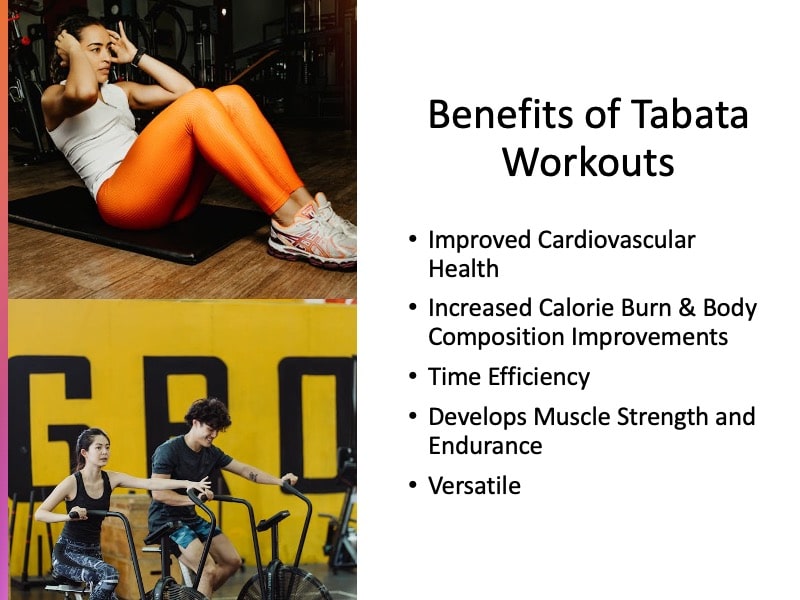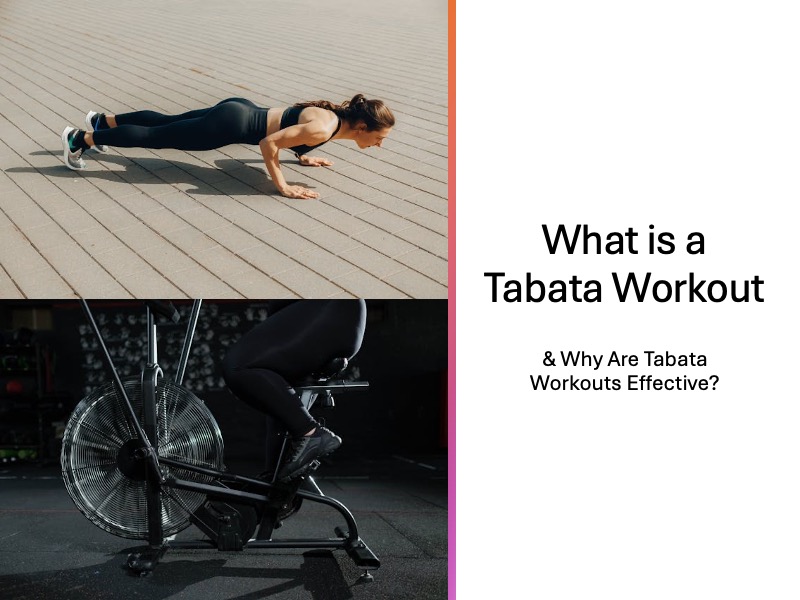What is a Tabata Workout & Why Are Tabata Workouts Effective?
Did you know that Tabata workouts are a quick way to achieve serious results?
I’ve been hooked on Tabata workouts ever since I first read about them during a study hall session in my freshman year of college.
These short yet powerful workouts can make a noticeable difference in your fitness routine. In just four minutes, they have the potential to transform your body while pushing you through plateaus that often hold back progress.
However, it’s important not to rely solely on Tabata workouts.
Instead, use them as a strategic metabolic conditioning tool to complement your overall training.
By targeting specific muscle groups or fitness goals, you can use Tabata workouts to amplify your results without overtraining, helping you build endurance, strength, or improve fat loss.
What is a Tabata Workout?
Tabata workouts are a form of high-intensity interval training (HIIT) developed by Japanese scientist Dr. Izumi Tabata.
Each set of the Tabta interval protocol consists of eight rounds of 20 seconds of maximum effort followed by 10 seconds of rest for a total of four minutes (Tabata, 2019).
The goal is to push your body to its limit during the work intervals, maximizing calorie burn, muscle engagement, and cardiovascular fitness in a short period.
Tabata can be applied to a variety of exercises, including bodyweight movements, weightlifting, or cardio exercises like sprinting or cycling.
This workout method is highly effective for improving aerobic and anaerobic capacity, enhancing endurance, and promoting fat loss. Its short duration makes it ideal for busy schedules while still providing substantial fitness benefits.
How Long is a Tabata Workout?
A standard Tabata workout lasts just 4 minutes.
It consists of:
- 8 rounds
- Each round is 20 seconds of maximum effort
- Followed by 10 seconds of rest
That adds up to 240 seconds, or 4 total minutes of intense interval training.
However, many people extend a Tabata-style workout by combining multiple 4-minute rounds, usually separated by 1-minute rest periods. For example:
- 20-minute Tabata session = 5 Tabata rounds
- Each round targets a different movement or muscle group
But by definition, a true Tabata protocol is a single 4-minute HIIT workout.
That’s what made it revolutionary — it was originally designed to elicit maximum aerobic and anaerobic improvements in the shortest time possible (Tabata et al., 1996).
How to Do a Tabata Workout?
Tabata training follows a specific high-intensity interval structure designed to push your limits in a short time.
Although it only takes four minutes, every second is meant to be performed with maximum effort. This style is most effective when used strategically, with proper form and intention.
Step 1.) Choose One (or More) High-Intensity Exercise(s)
Select an exercise that allows you to move explosively and continuously for short bursts. Full-body, compound movements work best. Examples include:
- Burpees
- Kettlebell swings
- Jump squats
- Sprints
- Stationary bike sprints
- Push-ups or thrusters
You can stick with one exercise for all 8 rounds or alternate between two movements (e.g., squats and push-ups).
Step 2.) Set a Timer for 8 Rounds of 20 Seconds On / 10 Seconds Off
Search “Tabata” on Spotify or Apple Music, or use a dedicated Tabata timer app, or interval timer.
Each round =
- 20 seconds of all-out, high-intensity effort
- 10 seconds of complete rest
Total workout time: 4 minutes
Warm-Up Beforehand
Although the workout is short, the intensity is high. To prevent injury and enhance performance, spend 5–10 minutes warming up with dynamic stretches, mobility drills, and light cardio.

Step 4.) Give Maximum Effort During Work Intervals
The effectiveness of Tabata comes from pushing your body to its limit during each 20-second interval. Aim for 90–100% of your max effort, which should leave you breathless by the end of each round.
After one full 4-minute Tabata cycle, you can either:
- Stop and recover, using it as a short metabolic finisher
- Rest 1 minute, then begin another Tabata with a new movement
Most full Tabata workouts include 2–4 rounds total (10–20 minutes).
Step 5.) Cool Down and Stretch
After the final round, bring your heart rate down gradually with light movement (walking, cycling) and finish with static stretches to aid recovery.
Benefits of Tabata Workouts

Tabata workouts offer one of the most efficient ways to improve fitness markers like VO₂ max, metabolic rate, and muscle endurance in minimal time.
Studies have shown that just four minutes of Tabata-style training can significantly boost both aerobic and anaerobic capacity — outperforming traditional steady-state cardio (Tabata et al., 1996).
Whether you’re aiming to get leaner, build strength, or simply fit a powerful training session into a packed schedule, the structure of Tabata unlocks high-level results without requiring hours in the gym.
The combination of maximum-effort intervals with short rest periods creates a metabolic disturbance that encourages fat loss, lean muscle maintenance, and cardiovascular improvement all at once.
Improved Cardiovascular Health
Tabata workouts, structured as high-intensity interval training (HIIT), push the cardiovascular system to its limits, enhancing both aerobic and anaerobic capacity.
This improves heart health, endurance, and overall cardiovascular efficiency quickly.
Increased Calorie Burn & Body Composition Improvements
Due to the intensity of Tabata workouts, the body burns a significant number of calories during and after exercise.
The afterburn effect, or excess post-exercise oxygen consumption (EPOC), causes the body to continue burning calories for hours post-workout.
Additionally, due to its high intensity, Tabata helps reduce body fat while preserving lean muscle mass.
The combination of strength and cardio makes it an efficient workout for improving body composition.
How Many Calories Does a Tabata Workout Burn?
A single 4-minute Tabata workout can burn approximately 40 to 60 calories, depending on the exercise intensity, your weight, and fitness level.
However, the real calorie-burning power of Tabata comes from its afterburn effect, known as excess post-exercise oxygen consumption (EPOC).
Because Tabata pushes your body into an oxygen debt, you continue burning calories for hours after the workout ends — potentially doubling the total calorie expenditure.
Here’s a rough breakdown based on research:
- During exercise: 8–15 calories per minute (depending on intensity and body weight)
- Total for 4 minutes: ~40–60 calories
- Including afterburn (EPOC): Up to 150–200 total calories in the hours following the workout (Børsheim & Bahr, 2003)
That’s a high return for just four minutes of effort — especially when using full-body, compound movements like burpees, jump squats, or kettlebell swings.
Time Efficiency
Each Tabata session typically lasts just four minutes, broken down into 20 seconds of maximum effort followed by 10 seconds of rest.
Despite the short duration, the intensity provides similar or even greater benefits than longer workout sessions, making it ideal for those with busy schedules.
Develops Muscle Strength and Endurance
Tabata workouts can target different muscle groups, enhancing strength and endurance.
Exercises like squats, push-ups, and burpees are commonly included, promoting functional strength and improving overall muscle tone.
Versatile
Tabata training is adaptable to different fitness levels and exercise preferences.
It can be done using bodyweight exercises, free weights, kettlebells, or even sprinting, making it suitable for various fitness goals and equipment availability.
Best Tabata Exercises for Strength & Weight Loss
The key to maximizing the impact of Tabata workouts lies in choosing movements that recruit large muscle groups, elevate your heart rate quickly, and challenge your muscular endurance.
When selected strategically, the best Tabata exercises can simultaneously build strength and accelerate fat loss — making them a powerful tool for body recomposition.
Whether you’re using bodyweight, dumbbells, kettlebells, or cardio machines, these exercises are designed to push you to the edge in short bursts, triggering metabolic stress, muscle activation, and sustained calorie burn long after the session ends.
Burpees
Burpees are one of the best Tabata exercises for weight loss and strength because they combine cardio, strength, and explosive movement into one high-intensity motion.
This full-body exercise targets the legs, core, chest, and arms while rapidly elevating your heart rate and driving calorie burn.
Their simplicity and scalability make them ideal for Tabata workouts, helping build muscular endurance, improve coordination, and accelerate fat loss in just a few rounds.
Squats
Squats, such as air squats and jump squats, are two of the best Tabata exercises for strength because they effectively target the glutes, quads, and hamstrings while also elevating your heart rate.
When performed in a Tabata format, they challenge both muscular endurance and cardiovascular capacity, making them perfect for fat loss and lower-body development.
Jump squats add an explosive element that enhances power output, while air squats allow for sustained high-rep sets with minimal fatigue.
Together, they create an efficient HIIT leg workout that burns calories and builds lean muscle in a short amount of time.
Mountain Climbers
Mountain climbers are one of the best Tabata exercises for weight loss because they combine core engagement, cardiovascular intensity, and full-body movement in a single motion.
They activate the shoulders, legs, and abs while rapidly spiking your heart rate, making them ideal for high effort intervals.
The fast-paced, ground-based motion challenges stability and endurance, helping you burn calories efficiently while building core strength and improving athletic conditioning.
Kettlebell Swings
Kettlebell swings are among the best Tabata exercises for strength because they develop explosive hip power while targeting the glutes, hamstrings, core, and lower back.
The dynamic, hinge-based movement builds posterior chain strength, improves posture, and enhances overall athleticism.
In a Tabata format, kettlebell swings generate high power output in short bursts, making them ideal for building strength, boosting metabolism, and torching calories — all in just four minutes.
Jumping Jacks
Jumping jacks are a simple yet powerful full-body cardio movement, making them one of the best Tabata exercises for weight loss—especially for beginners or as an active recovery round.
They engage the legs, arms, and core while promoting coordination and rhythmic movement.
Their consistent, low-impact nature helps maintain an elevated heart rate throughout the Tabata session, improving cardiovascular endurance and supporting calorie burn without requiring equipment or advanced technique.
Thrusters (Squat and Press)
Thrusters are one of the best Tabata exercises for strength because they combine two powerful movements—squats and overhead presses—into a single, total-body exercise.
This compound motion activates the legs, shoulders, core, and arms simultaneously, challenging muscular endurance and coordination.
In a Tabata interval workout, thrusters deliver both strength training and cardiovascular conditioning, making them incredibly efficient for building lean muscle, improving metabolic health, and boosting overall fitness in minimal time.
Sprinting
Though often overlooked, sprinting is one of the best Tabata exercises for weight loss and cardiovascular conditioning.
Short, all-out sprints push your body to peak intensity, maximizing heart rate, calorie burn, and metabolic demand within each 20-second interval.
This high-impact exercise efficiently improves both anaerobic power and aerobic capacity, making it ideal for fat loss, speed development, and overall athletic performance in a condensed timeframe.
Stationary Bike
The stationary bike is one of the best Tabata exercises for weight loss and lower-body endurance because it allows for maximum intensity with minimal impact on the joints.
By increasing resistance and sprinting during the 20-second work intervals, you can push your cardiovascular system to its peak while simultaneously strengthening the quads, hamstrings, and glutes.
Its controlled environment makes it an ideal option for all fitness levels, delivering a safe yet highly effective way to burn calories, improve aerobic capacity, and build muscular endurance in a short amount of time.
Using an air bike (also known as an assault bike) is an even better option if available — combining upper and lower body engagement with fan-driven resistance that increases as you push harder.
While air bikes aren’t as common in home gyms or commercial fitness centers, they are excellent for full-body Tabata workouts and unmatched in intensity.
Med Ball Over Shoulder
The med ball over-shoulder toss is a powerful, full-body movement that ranks among the best Tabata exercises for strength and explosive conditioning.
Each rep of this med ball exercise demands forceful hip extension, core stabilization, and upper body power, making it ideal for developing functional strength and athleticism.
As you repeatedly lift and throw the ball over your shoulder, your heart rate climbs rapidly, turning this strength-based exercise into a highly effective cardiovascular challenge as well — perfect for Tabata’s high-intensity format.
Erg Rowing
The ERG rowing machine is one of the best Tabata exercises for weight loss and total-body conditioning.
With every stroke, it targets the legs, core, back, and arms.
It also delivers a smooth, low-impact motion that elevates heart rate quickly while engaging multiple muscle groups simultaneously.
When performed in Tabata format, rowing becomes one of the best erg workouts available — combining high-intensity cardio with full-body resistance to build muscular endurance, burn fat, and improve overall conditioning in just minutes.
Battle Ropes
Battle ropes are one of the best Tabata exercises for weight loss and upper-body conditioning, delivering intense cardiovascular effort while engaging the shoulders, arms, core, and even the legs.
The constant, rapid motion forces your muscles to work under tension while keeping your heart rate elevated — a perfect match for Tabata’s high-effort intervals.
What makes battle ropes so effective is their versatility.
Even simple movements can be scaled in intensity for beginners or advanced athletes.
Basic battle rope Tabata exercises include:
- Alternating Waves – Rapidly lift and lower each arm in an alternating rhythm, building shoulder endurance and core stability.
- Double Waves – Move both arms simultaneously to create powerful, synchronized waves — excellent for total upper-body fatigue.
- Slams – Explosively lift the ropes overhead and slam them down, engaging the entire body for maximum power output and calorie burn.
- Circles – Move your arms in inward or outward circles to activate the chest, shoulders, and upper back with dynamic control.
With battle ropes, the resistance comes from your effort — the harder and faster you move, the more intense the workout becomes.
This self-regulating intensity makes them ideal for Tabata training, helping you build muscular endurance, burn fat, and improve athletic performance in a short time.
Final Thoughts: Are Tabata Workouts Effective & Good for You?
Yes — Tabata workouts are highly effective and undeniably good for you when used strategically within a balanced fitness program. In just four minutes, they can significantly improve cardiovascular health, build muscular endurance, stimulate fat loss, and elevate metabolic rate through the afterburn effect.
What sets Tabata apart is its time efficiency and intensity. It delivers full-body results in a fraction of the time compared to traditional training methods, making it ideal for busy schedules or as a high-impact finisher to longer workouts.
However, Tabata’s effectiveness depends on maximal effort during each interval and proper recovery between sessions.
Overuse can lead to burnout or injury, so it’s best used as a complement — not a replacement — to structured strength training, mobility work, and active recovery.
Whether your goal is weight loss, strength building, or simply breaking through a training plateau, Tabata workouts are a smart, science-backed tool that can help you push past limits and unlock noticeable results.



